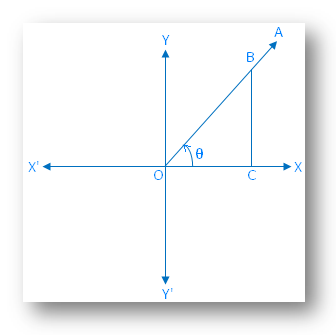Subscribe to our ▶️ YouTube channel 🔴 for the latest videos, updates, and tips.
Rules of Trigonometric Signs
In this section we will learn about the rules of trigonometric signs. On a plane paper let O be a fixed point. Draw two mutually perpendicular lines \(\overrightarrow{XOX'}\) and \(\overrightarrow{YOY'}\) through O divide the plane paper into four quadrants.
We know that, the distance measured from O along \(\overrightarrow{XO}\) is positive and that along \(\overrightarrow{OX'}\) is negative; similarly again, the distance from O along \(\overrightarrow{OY}\) is positive and that along \(\overrightarrow{OY'}\) is negative.
Now, take a rotating line \(\overrightarrow{OA}\) rotates about O in the clockwise or anti-clockwise direction and starting from the initial position angle ∠XOA = θ. Depending on the value of θ the final arm \(\overrightarrow{OA}\) may be in the first quadrant or second quadrant or third quadrant or fourth quadrant. Take a point B on \(\overrightarrow{OA}\) and draw \(\overline{BC}\) perpendicular to \(\overrightarrow{OX}\) (or, \(\overrightarrow{OX'}\)).
|
Diagram 1: (i) \(\overline{OC}\) will be positive if it is measured from O along \(\overrightarrow{OX}\) (ii) \(\overline{CB}\) will be positive if it is measured from O along \(\overrightarrow{OY}\) (iii) \(\overline{OB}\) is positive of the final arm \(\overrightarrow{OA}\) |
Diagram 1 |
|
Diagram 2: (i) \(\overline{OC}\) will be negative if it is measured from O along \(\overrightarrow{OX'}\) (ii) \(\overline{CB}\) will be positive if it is measured from O along \(\overrightarrow{OY}\) (iii) \(\overline{OB}\) is positive of the final arm \(\overrightarrow{OA}\) |
Diagram 2 |
|
Diagram 3: (i) \(\overline{OC}\) will be negative if it is measured from O along \(\overrightarrow{OX'}\) (ii) \(\overline{CB}\) will be negative if it is measured from O along \(\overrightarrow{OY'}\) (iii) \(\overline{OB}\) is positive of the final arm \(\overrightarrow{OA}\) |
Diagram 3 |
|
Diagram 4: (i) \(\overline{OC}\) will be positive if it is measured from O along \(\overrightarrow{OX}\) (ii) \(\overline{CB}\) will be negative if it is measured from O along \(\overrightarrow{OY'}\) (iii) \(\overline{OB}\) is positive of the final arm \(\overrightarrow{OA}\) |
Diagram 4 |
Therefore, the rules of trigonometric signs of the sides of the right-angled triangle OBC are as follows:
(i) \(\overline{OC}\) will be positive if it is measured from O along \(\overrightarrow{OX}\) as shown in the diagram 1 and diagram 4
(ii) \(\overline{OC}\) will be negative if it is measured from O along \(\overrightarrow{OX'}\) as shown in the diagram 2 and diagram 3
(iii) \(\overline{CB}\) will be positive if it is measured from O along \(\overrightarrow{OY}\) as shown in the diagram 1 and diagram 2
(iv) \(\overline{CB}\) will be negative if it is measured from O along \(\overrightarrow{OY'}\) as shown in the diagram 3 and diagram 4
(v) \(\overline{OB}\) is positive for all positions of the final arm \(\overrightarrow{OA}\).
● Trigonometric Functions
- Basic Trigonometric Ratios and Their Names
- Restrictions of Trigonometrical Ratios
- Reciprocal Relations of Trigonometric Ratios
- Quotient Relations of Trigonometric Ratios
- Limit of Trigonometric Ratios
- Trigonometrical Identity
- Problems on Trigonometric Identities
- Elimination of Trigonometric Ratios
- Eliminate Theta between the equations
- Problems on Eliminate Theta
- Trig Ratio Problems
- Proving Trigonometric Ratios
- Trig Ratios Proving Problems
- Verify Trigonometric Identities
- Trigonometrical Ratios of 0°
- Trigonometrical Ratios of 30°
- Trigonometrical Ratios of 45°
- Trigonometrical Ratios of 60°
- Trigonometrical Ratios of 90°
- Trigonometrical Ratios Table
- Problems on Trigonometric Ratio of Standard Angle
- Trigonometrical Ratios of Complementary Angles
- Rules of Trigonometric Signs
- Signs of Trigonometrical Ratios
- All Sin Tan Cos Rule
- Trigonometrical Ratios of (- θ)
- Trigonometrical Ratios of (90° + θ)
- Trigonometrical Ratios of (90° - θ)
- Trigonometrical Ratios of (180° + θ)
- Trigonometrical Ratios of (180° - θ)
- Trigonometrical Ratios of (270° + θ)
- Trigonometrical Ratios of (270° - θ)
- Trigonometrical Ratios of (360° + θ)
- Trigonometrical Ratios of (360° - θ)
- Trigonometrical Ratios of any Angle
- Trigonometrical Ratios of some Particular Angles
- Trigonometric Ratios of an Angle
- Trigonometric Functions of any Angles
- Problems on Trigonometric Ratios of an Angle
- Problems on Signs of Trigonometrical Ratios
11 and 12 Grade Math
From Rules of Trigonometric Signs to HOME PAGE
Didn't find what you were looking for? Or want to know more information about Math Only Math. Use this Google Search to find what you need.






New! Comments
Have your say about what you just read! Leave me a comment in the box below. Ask a Question or Answer a Question.